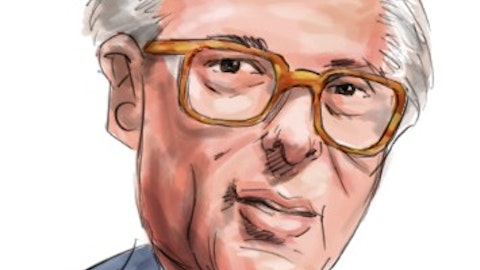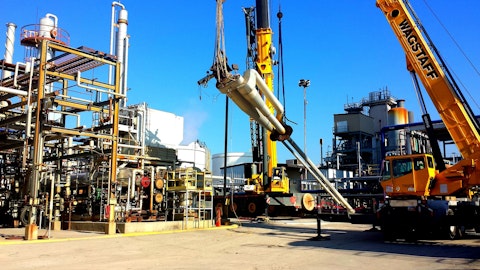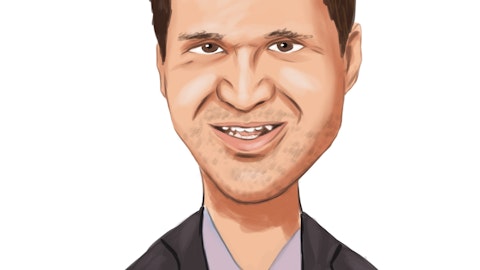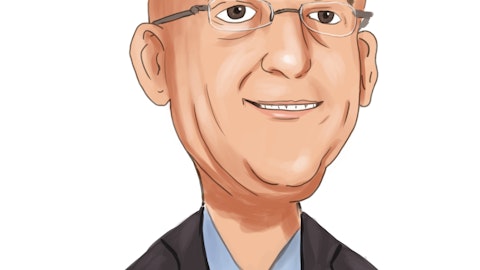Leonardo Marcondes: Now that you have a healthier network and more robust network of service stations is there still room to improve your receivables?
Rodrigo Pizzinatto: I don’t think that’s relevant, Leonardo. The effect on receivables reflects the best situation in terms of receivable now. So we don’t have any additional recognition – in the future or looking forward.
Leonardo Marcondes: Okay, thank you.
Rodrigo Pizzinatto: And Leonardo, to your last question about if there is any room for improvement
Leonardo Marcondes: And you talked about the four pillars.
Rodrigo Pizzinatto: Oh yes, the four pillars.
Leonardo Marcondes: Yes. In your Investor Day, you mentioned the four pillars. And the point that there’s still room to do more in terms of trade and logistics. So I want to know if you’ve seen any evolution since then that you can share with us.
Rodrigo Pizzinatto: So first just a general comment. I don’t like talking about turnaround anymore because I think they’re past that but I want to talk about improvement processes. And yes, indeed in line with the four pillars that we have been discussing for a long time now, we even said in Ultra Day, and we have our logistics pillar, which is more of a structural pillar and it will still take us some time until we can actually enhance and potentialize the improvement that we see for this pillar. We’re expecting to potentially gain by the end of 2025. But you’re right certainly we have room to improve further in Ipiranga’s operations.
Leonardo Marcondes: Very clear. Thank you.
Operator: The next question comes from Thiago Duarte, BTG Pactual.
Thiago Duarte: Thank you. Good morning. Let me bring back the discussion to Ipiranga. We already talked about the margin with some very good information. But I heard Linden talking about this. When we talk about your brand strategy because I think that these two things are related. But I want to go back to the topic of the share because until the first – the end of the first quarter there was as you said there was excess product in the market, excess molecules. So you had a consistent loss of share not just for Ipiranga but for the main – the three main businesses in the industry – in the three main companies in the industry. And now in the second half, there seems to be a recovery in the share and we talked about the imports from Russia but this loss of share also took place in the Otto cycle.
So I want to hear from Linden, I know that this is not the utmost goal of everything but I believe that we have better operations now in a more balanced market and your value proposition after the turnaround is finished and your value proposition is very consistent and positive. I believe that you are expecting a resumption or a recovery in your market share or your volume as a positive symptom of this turnaround. So do you think it makes sense to think of this evolution as a positive indicator looking forward? Also considering your brand strategy, I think this positive value proposition will increase the opportunity to explore your brand. And as you said, you’re raising the bar every time. This is my question. And my second question is for Marcos.
And we know that the company’s leverage today is much lower. You have a good cash generation and your results are improving more and more. So the market wants to know about your next movement. Have you discussed at a high level – you discussed this at a high level during Ultra Day and Marcos talked about this in this call. But my question is what format should we expect for your capital allocation movement in the future aiming at growing the company? I heard from Marcos during the Ultra Day, that company no longer has [indiscernible] of having to control 100% of the business. You’re thinking of partnerships or minority stakes. So Marcos, I don’t know if you can — well, after time has passed can you give us more information about what we can expect and what — if the company is willing to hold minority stakes or non-controlling stakes on other companies?
And what are the companies that you’re considering in this pipeline? Thank you.
Leonardo Linden: Thiago, let me answer your first question. First, in terms of market share, we need to break this for example if you look at the share of contracted volume in our own network, we don’t have any loss of share. If you look in the last two years there was an evolution in our share, where we actually lost share because of the market decision that made was in the spot market. And this is due to issues related with supply — the supply issues that we had in the first half of this year. Now the spot market represents a price-sensitive volume. So when you think you’re recovering as good start then you can go back and compete in that market. So the — we prioritize the supply to our own network, because we were more concerned with supply at that time.
So that’s why we made this a top priority. And we stopped temporarily the supply in the spot market. I’m not reconfirmed with the share the share is a consequence. What’s important is the scale to volume and the share is a consequence of the quality of your value proposition and the work that you do. If you make high-quality investments and you have high-quality operations the share will come naturally. And for the spot market we will work on the spot market as it goes back to making sense to the company.
Marcos Lutz: Thiago, first, I think that our role here as a, capital allocators, is to not be anxious or not to be as anxious as the rest of the market. We have to carefully look at the opportunities and we don’t control their timing. We have to be prepared for the opportunities. And this we have been doing really well. Our balance today is well prepared for any opportunities that may arise in the future. But having said this, indeed, our main drivers here are the risk and the return that we expect from those projects. And our three businesses have been making investments and have been looking for avenues of growth. In some cases we made some small acquisitions and organic acquisitions which is the case of Ultragaz which is now growing organically with the companies acquired.
Also in cargo, we have a project of exploring the inner part of the country and out of the capitals with a broader logistics offer. Now as for Ultrapar, I think that first in Ultrapar, we have a higher requirement or a high-return because the money is closer to the shareholders so we need to have higher return rates, for those projects. Now in terms of the format, which was your specific question, we have fewer paradigms today, but we will not make investments where we do not have a relevant influence and where that business is heading. So we are adding value with the strategy, the structure, the business model and we will not go for acquisitions where this cannot be leveraged. So I don’t have to acquire 100% of a company. I don’t need to be a controller, at least not initially, but I need to have a clear path in terms of the influence, I want to have on that business.
So for example, acquiring a minority stake is not something that interests us because there will be a controller in the picture. So at the end of the day, we have a high-level of clarity about what we want, but no we do not necessarily need to acquire 100% of another company. What we need is to have a good return on investment versus the risk. And we want to buy efficiently. It is better to go for those projects and just buy 100% of the company and trying to control the timing of a transaction which is not something that is under our control. I hope, I answered your question.




